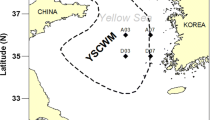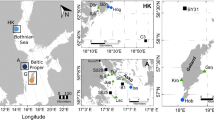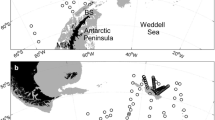Abstract
Stable isotope (SI) ratios of carbon (δ13C) and nitrogen (δ15N) were measured in omnivorous and carnivorous deep-sea copepods of the families Euchaetidae and Aetideidae across the Atlantic sector of the Southern Ocean to establish their trophic positions. Due to high and variable C/N ratios related to differences in lipid content, δ13C was corrected using a lipid-normalisation model. δ15N signals ranged from 3.0–6.9‰ in mesopelagic species to 7.0–9.5‰ in bathypelagic congeners. Among the carnivorous Paraeuchaeta species, the epi- to mesopelagic species Paraeuchaeta antarctica had lower δ15N values than the mesopelagic P. rasa and bathypelagic P. barbata. The same trend was observed among omnivorous Aetideidae, but was not significant. In the most abundant species P. antarctica, individuals from the western Atlantic had higher δ13C and δ15N values than specimens at the eastern stations. These longitudinal changes in δ13C and δ15N values were attributed to regional differences in hydrography and sea surface temperature (SST), in particular related to a northward extension of the Antarctic Polar Front (APF) at the easternmost stations. The results indicate that even in a mesopelagic carnivorous species, the changes in surface stable isotope signatures are pronounced.




Similar content being viewed by others
References
Altabet MA (1988) Variations in nitrogen isotopic composition between sinking and suspended particles: implications for nitrogen cycling and particle transformation in the open ocean. Deep Sea Res 35:535–554
Altabet MA, François R (1994a) Sedimentary nitrogen isotopic ratio as a recorder for surface ocean nitrate utilization. Global Biogeochem Cycles 8:103–116
Altabet MA, François R (1994b) The use of nitrogen isotopic ratio for reconstruction of past changes in surface ocean nutrient utilization. In: Zahn R, Pedersen TF, Kaminski MA, Labeyrie L (eds) Carbon cycling in the Glacial Ocean: constraints on the ocean’s role in global change. Springer, Berlin, pp 281–306
Altabet MA, Small LF (1990) Nitrogen isotopic ratios in fecal pellets produced by marine zooplankton. Geochim Cosmochim Acta 54:155–163
Auel H (1999) The ecology of Arctic deep-sea copepods (Euchaetidae and Aetideidae). Aspects of their distribution, trophodynamics and effect on the carbon flux. Ber Polarforsch 319:1–97
Auel H, Hagen W (2002) Mesozooplankton community structure, abundance and biomass in the central Arctic Ocean. Mar Biol 140:1013–1021
Bergmann M, Dannheim J, Bauerfeind E, Klages M (2009) Trophic relationships along a bathymetric gradient at the deep-sea observatory HAUSGARTEN. Deep Sea Res 56:408–424
Best PB, Schell DM (1996) Stable isotopes in southern right whale (Eubalaena australis) baleen as indicators of seasonal movements, feeding and growth. Mar Biol 124:483–494
Checkley DMJ, Entzeroth LC (1985) Elemental and isotopic fractionation of carbon and nitrogen by marine, planktonic copepods and implications to the marine nitrogen cycle. J Plankton Res 7:553–568
Cherel Y, Hobson KA (2007) Geographical variation in carbon stable isotope signatures of marine predators: a tool to investigate their foraging areas in the Southern Ocean. Mar Ecol Prog Ser 329:281–287
Cherel Y, Hobson KA, Weimerskirch H (2000) Using stable-isotope analysis of feathers to distinguish moulting and breeding origins of seabirds. Oecologia 122:155–162
Dehairs F, Kopczynska E, Nielsen P, Lancelot C, Bakker DCE, Koevei W, Goeyens L (1997) δ13C of Southern Ocean suspended organic matter during spring and early summer: regional and temporal variability. Deep Sea Res 44:129–142
DeNiro MJ, Epstein S (1978) Influence of diet on the distribution of carbon isotopes in animals. Geochim Cosmochim Acta 42:495–506
François R, Altabet MA, Goericke R, McCorkle DC, Brunet C, Poisson A (1993) Changes in the 13C of surface water particulate organic matter across the subtropical convergence in the SW Indian Ocean. Global Biogeochem Cycles 7:627–644
Frazer TK (1996) Stable isotope composition (δ13C and δ15N) of larval krill, Euphausia superba, and two of its potential food sources in winter. J Plankton Res 18:1413–1426
Gladbach A, McGill RAR, Quillfeldt P (2007) Foraging areas of Wilson’s storm-petrel Oceanites oceanicus in the breeding and inter-breeding period determined by stable isotope analysis. Polar Biol 30:1005–1012
Goering J, Alexander V, Haubenstock N (1990) Seasonal variability of stable carbon and nitrogen isotope ratios of organisms in a North Pacific Bay. Estuar Coast Shelf Sci 30:239–260
Hobson KA (1999) Tracing origins and migration of wildlife using stable isotopes: a review. Oecologia 120:314–326
Hobson KA, Welch HE (1992) Determination of trophic relationships within a high Arctic marine food web using δ 13C and δ 15N analysis. Mar Ecol Prog Ser 84:9–18
Hobson KA, Fisk A, Karnovsky N, Holst M, Gagnon JM, Fortier M (2002) A stable isotope (δ13C, δ15N) model for the North Water food web: implications for evaluating trophodynamics and the flow of energy and contaminants. Deep Sea Res 49:5131–5150
Holmes ME, Eichner C, Struck U, Wefer G (1999) Reconstruction of surface ocean nutrient utilization using stable nitrogen isotopes in sinking particles and sediments. In: Fischer G, Wefer G (eds) The use of proxies in paleoceanography: examples from the South Atlantic. Springer, Berlin, pp 447–468
Hopkins TL (1985) The zooplankton community of Croker Passage, Antarctic Peninsula. Polar Biol 4:161–170
Hopkins TL, Torres JJ (1988) The zooplankton community in the vicinity of the ice edge, western Weddell Sea, March 1986. Polar Biol 9:79–87
Hopkins TL, Lancraft TM, Torres JJ, Donnelly J (1993) Community structure and trophic ecology of zooplankton in the Scotia Sea marginal ice zone in winter (1988). Deep Sea Res 40:81–105
Iken K, Bluhm BA, Gradinger R (2005) Food web structure in the high Arctic Canada Basin: evidence from δ13C and δ15N analysis. Polar Biol 28:238–249
Jacob U, Mintenbeck K, Brey T, Knust R, Beyer K (2005) Stable isotope food web studies: a case for standardized sample treatment. Mar Ecol Prog Ser 287:251–253
Koppelmann R, Böttger-Schnack R, Möbius J, Weikert H (2009) Trophic relationships of zooplankton in the eastern Mediterranean based on stable isotope measurements. J Plankton Res 31:669–686
Laakmann S, Stumpp M, Auel H (2009) Vertical distribution and dietary preferences of deep-sea copepods (Euchaetidae and Aetideidae; Calanoida) in the vicinity of the Antarctic Polar Front. Polar Biol 32:679–689
McConnaughey T, McRoy CP (1979) Food-web structure and the fractionation of carbon isotopes in the Bering Sea. Mar Biol 53:257–262
McCutchan JH Jr, Lewis M Jr, Kendall C, McGrath CC (2003) Variation in trophic shift for stable isotope ratios of carbon, nitrogen, and sulfur. Oikos 102:378–390
Minagawa M, Wada T (1984) Stepwise enrichment of 15N along food chains: further evidence and the relation between δ15N and animal age. Geochim Cosmochim Acta 48:1135–1140
Mintenbeck K, Jacob U, Knust R, Arntz WE, Brey T (2007) Depth-dependence in stable isotope ratio δ15N of benthic POM consumers: the role of particle dynamics and organism trophic guild. Deep-Sea Res 54:1015–1023
Mintenbeck K, Brey T, Jacob U, Knust R, Struck U (2008) How to account for the lipid effect on carbon stable-isotope ratio (δ13C): sample treatment effects and model bias. J Fish Biol 72:815–830
Montoya JP (1994) Nitrogen isotope fractionation in the modern ocean: implications for the sedimentary record. In: Zahn R, Pedersen TF, Kaminski MA, Labeyrie L (eds) Carbon cycling in the Glacial Ocean: constraints on the ocean’s role in global change. Springer, Berlin, pp 259–279
Montoya JP, Carpenter EJ, Capone DG (2002) Nitrogen fixation and nitrogen isotope abundances in zooplankton of the oligotrophic North Atlantic. Limnol Oceanogr 47:1617–1628
Moore JK, Abbott MR, Richman JG (1999) Location and dynamics of the Antarctic Polar Front from satellite sea surface temperature data. J Geophys Res 104:3059–3073
Nyssen F, Brey T, Lepoint G, Dauby P, Bouquegneau JM, De Broyer C (2002) A stable isotope approach to the eastern Wedell Sea trophic web: focus on benthic amphipods. Polar Biol 25:280–287
Olsen EM, Jørstad T, Kaartvedt S (2000) The feeding strategies of two large marine copepods. J Plankton Res 22:1513–1528
Øresland V (1995) Winter population structure and feeding of the chaetognath Eukrohnia hamata and the copepod Euchaeta antarctica in Gerlache Strait, Antarctic Peninsula. Mar Ecol Prog Ser 119:77–86
Øresland V, Ward P (1993) Summer and winter diet of four carnivorous copepod species around South Georgia. Mar Ecol Prog Ser 98:73–78
Park T (1994) Taxonomy and distribution of the marine calanoid copepod family Euchaetidae. Bulletin of the Scripps Institution of Oceanography. University of California, San Diego, p 29
Peters KE, Walters CC, Moldowan JM (2005) The biomarker guide: biomarkers and isotopes in the environment and human history, vol 1. Cambridge University Press, Cambridge
Pollard RT, Lucas MI, Read JF (2002) Physical controls on biogeochemical zonation in the Southern Ocean. Deep Sea Res 49:3289–3305
Polunin NVC, Morales-Nin B, Pawsey WE, Cartes JE, Pinnegar JK, Moranta J (2001) Feeding relationships in Mediterranean bathyal assemblages elucidated by stable nitrogen and carbon isotope data. Mar Ecol Prog Ser 220:13–23
Post DM (2002) Using stable isotopes to estimate trophic position: models, methods, and assumptions. Ecology 83:703–718
Rau GH, Takahashi T, De Marais DJ (1989) Latitudinal variations in plankton δ13C: implications for CO2 and productivity in past oceans. Nature 341:516–518
Rau GH, Hopkins TL, Torres JJ (1991a) 15N/14N and 13C/12C in Weddell Sea invertebrates: implications for feeding diversity. Mar Ecol Prog Ser 77:1–6
Rau GH, Takahashi T, Des Marais DJ, Sullivan CW (1991b) Particulate organic matter δ13C variations across the Drake Passage. J Geophys Res 96:15131–15135
Rau GH, Ainley DG, Bengtson JL, Torres JJ, Hopkins TL (1992a) 15N/14N and 13C/12C in Weddell Sea birds, seals, and fish: implications for diet and trophic structure. Mar Ecol Prog Ser 84:1–8
Rau GH, Takahashi T, Des Marais DJ, Repeta DJ, Martin JH (1992b) The relationship between δ13C of organic matter and [CO2(aq)] in ocean surface water: data from a JGOFS site in the northeast Atlantic ocean and a model. Geochim Cosmochim Acta 56:1413–1419
Schmidt K, Atkinson A, Stübing D, McClelland JW, Montoya JP, Voss M (2003) Trophic relationships among Southern Ocean copepods and krill: some uses and limitations of a stable isotope approach. Limnol Oceanogr 48:277–289
Schnack-Schiel SB, Hagen W, Mizdalski E (1998) Seasonal carbon distribution of copepods in the eastern Weddell Sea, Antarctica. J Mar Syst 17:305–311
Schnack-Schiel SB, Michels J, Mizdalski E, Schodlok MP, Schröder M (2008) Composition and community structure of zooplankton in the sea ice-covered western Weddell Sea in spring 2004—with emphasis on calanoid copepods. Deep Sea Res 55:1040–1055
Smyntek PM, Teece MA, Schulz KL, Thackeray SJ (2007) A standard protocol for stable isotope analysis of zooplankton in aquatic food web research using mass balance correction models. Limnol Oceanogr 52:2135–2146
Søreide JE, Hop H, Carroll ML, Falk-Petersen S, Hegseth EN (2006a) Seasonal food web structures and sympagic-pelagic coupling in the European Arctic revealed by stable isotopes and a two-source food web model. Prog Oceanogr 71:59–87
Søreide JE, Tamelander T, Hop H, Hobson KA, Johansen I (2006b) Sample preparation effects on stable C and N isotope values: a comparison of methods in Arctic marine food web studies. Mar Ecol Prog Ser 328:17–28
Sugisaki H, Tsuda A (1995) Nitrogen and carbon stable isotopic ecology in the ocean: the transportation of organic materials through the food web. In: Sakai H, Nozaki Y (eds) Biochemical processes and ocean flux in the Western Pacific. Terra Scientific Publishing Company (TERRAPUB), Tokyo, pp 307–317
Tamelander T, Søreide JE, Hop H, Carroll ML (2006) Fractionation of stable isotopes in the Arctic marine copepod Calanus glacialis: effects on the isotopic composition of marine particulate organic matter. J Exp Mar Biol Ecol 333:231–240
Tieszen LL, Boutton TW, Tesdahl KG, Slade NA (1983) Fractionation and turnover of stable carbon isotopes in animal tissues: implications for δ13C analysis of diet. Oecologia 57:32–37
Trull TW, Armand L (2001) Insights into Southern Ocean carbon export from the δ13C of particles and dissolved inorganic carbon during the SOIREE iron fertilisation experiment. Deep Sea Res 48:2655–2680
Vander Zanden MJ, Rasmussen JB (1999) Primary consumer δ13C and δ15N and the trophic position of aquatic consumers. Ecology 80:1395–1404
Wada E, Terazaki M, Kabaya Y, Nemoto T (1987) 15N and 13C abundances in the Antarctic Ocean with emphasis on the biogeochemical structure of the food web. Deep Sea Res 34:829–841
Ward P, Wood AG (1988) The distribution of the Euchaetidae (Copepoda: Calanoida) around South Georgia. Polar Biol 9:45–52
Yen J (1987) Predation by a carnivorous marine copepod, Euchaeta norvegica Boeck, on eggs and larvae of the North Atlantic cod Gadus morhua L. J Exp Mar Biol Ecol 112:283–296
Acknowledgments
We are grateful to the captain and crew of R/V Polarstern for their skilful support during the cruise. Meike Stumpp assisted in sampling and field work. This study was funded by Deutsche Forschungsgemeinschaft (DFG project AU 175/3).
Author information
Authors and Affiliations
Corresponding author
Additional information
Communicated by U. Sommer.
Rights and permissions
About this article
Cite this article
Laakmann, S., Auel, H. Longitudinal and vertical trends in stable isotope signatures (δ13C and δ15N) of omnivorous and carnivorous copepods across the South Atlantic Ocean. Mar Biol 157, 463–471 (2010). https://doi.org/10.1007/s00227-009-1332-9
Received:
Accepted:
Published:
Issue Date:
DOI: https://doi.org/10.1007/s00227-009-1332-9




